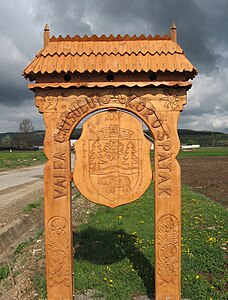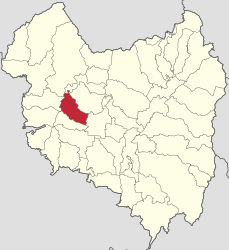Valea Crișului
Commune in Covasna, Romania From Wikipedia, the free encyclopedia
Commune in Covasna, Romania From Wikipedia, the free encyclopedia
Valea Crișului (Hungarian: Sepsikőröspatak [ˈʃɛpʃikørøʃpɒtɒk]) is a commune in Covasna County, Transylvania, Romania composed of two villages: Calnic (Kálnok) and Valea Crișului. In 2004, the village of Arcuș split away from Valea Crișului to form an independent commune.
This article needs additional citations for verification. (February 2020) |
Valea Crișului
Sepsikőröspatak | |
|---|---|
 Entrance to Valea Crișului | |
 Location in Covasna County | |
| Coordinates: 45°55′N 25°46′E | |
| Country | Romania |
| County | Covasna |
| Government | |
| • Mayor (2020–2024) | Sándor Kisgyőrgy[1] (UDMR) |
| Area | 27.85 km2 (10.75 sq mi) |
| Elevation | 606 m (1,988 ft) |
| Population (2021-12-01)[2] | 2,354 |
| • Density | 85/km2 (220/sq mi) |
| Time zone | EET/EEST (UTC+2/+3) |
| Postal code | 527165 |
| Area code | (+40) 02 67 |
| Vehicle reg. | CV |
| Website | www |
The settlement formed part of the Székely Land region of the historical Transylvania province. Until 1918, the village belonged to the Háromszék County of the Kingdom of Hungary. In the immediate aftermath of World War I, following the declaration of the Union of Transylvania with Romania, the area passed under Romanian administration during the Hungarian–Romanian War of 1918–1919. By the terms of the Treaty of Trianon of 1920, it became part of the Kingdom of Romania.
In 1925, the commune fell within Plasa Sfântu Gheorghe of Trei Scaune County. In August 1940, under the auspices of Nazi Germany, which imposed the Second Vienna Award, Hungary retook the territory of Northern Transylvania (which included Valea Crișului) from Romania. Towards the end of World War II, however, the commune was taken back from Hungarian and German troops by Romanian and Soviet forces in September 1944.
In 1950, after Communist Romania was established, Valea Crișului became part of the Sfântu Gheorghe Raion of Stalin Region. From 1952 and 1960, it was part of the Magyar Autonomous Region, and between 1960 and 1968 it reverted to Brașov Region. In 1968, when Romania was reorganized based on counties rather than regions, the commune became part of Covasna County.
| Year | Pop. | ±% |
|---|---|---|
| 1850 | 1,538 | — |
| 1930 | 1,952 | +26.9% |
| 1977 | 2,184 | +11.9% |
| 2002 | 2,175 | −0.4% |
| 2011 | 2,307 | +6.1% |
| 2021 | 2,354 | +2.0% |
| Source: Census data | ||
The commune has an absolute Székely Hungarian majority. According to the 2002 census, it had a population of 2,175, of which 98.44% were Hungarians. At the 2011 census, it had 2,307 inhabitants, of which 92.59% were Hungarians and 1.04% Romanians. At the 2021 census, Valea Crișului had a population of 2,354, of which 91.67% were Hungarians and 1.32% Romanians.[3]

The neighboring village of Calnic (3 km) belongs administratively to Valea Crișului.
The masterpiece of wood carving is the 18th-century bell tower at Calnic, covered by two wooden. The Unitarian church next to it dates from 1781. Not a single iron nail was used in its construction. Both structures are listed monuments.
The Unitarian church at Calnic, dating to 1674, is a historic monument. Its floral-patterned coffered ceiling dates from the same century. Its two carved portals are the work of folk artists Dénes Nemes and András Bálint.
Valea Crișului
Calnic
Seamless Wikipedia browsing. On steroids.
Every time you click a link to Wikipedia, Wiktionary or Wikiquote in your browser's search results, it will show the modern Wikiwand interface.
Wikiwand extension is a five stars, simple, with minimum permission required to keep your browsing private, safe and transparent.